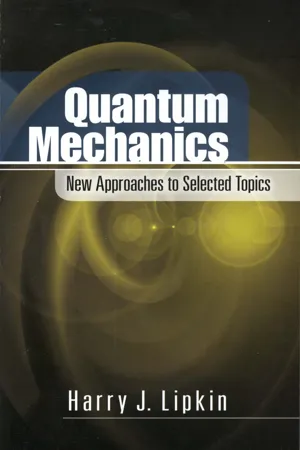![]()
MOMENTUM TRANSFER TO BOUND SYSTEMS AND THE Mössbauer EFFECT
This monograph in chs. 2, 3 and 4 introduces the student to interesting problems of ‘form factor physics’ at the frontier of the present research as well as to many basic concepts and mathematical techniques. It begins from a level requiring only very elementary formalism; namely the description of a free particle and a harmonic oscillator and the transformations between different bases.
The form factor concept arises in all investigations of the structure of complex microscopic systems, e.g. X-ray crystallography, light scattering by atoms, electron scattering from nucleons and nuclei and nuclear beta decay. All these processes are described by a transition amplitude containing a form factor which depends only on the properties of the bound system (e.g. the crystal) and the kinematics of the transition process (momentum and energy transfer or wavelengths and frequencies) and it is independent of the details of the elementary radiation, scattering or absorption process. This separation of the form factor from the elementary process makes possible a derivation of the form factor at a very elementary level and a unified description of the applications in all areas of physics.
Form factor physics provides an excellent introduction to wave-particle duality, complementarity and the uncertainty principle because the emitted, absorbed and scattered radiation can be described as either a classical wave or a beam of classical particles. The result for the form factor is obtainable in the two complementary descriptions, either in terms of wavelengths and frequencies of waves or of momenta and energies of particles. In the wave description the form factor describes the spatial size and structure of the system, determined because the waves coming from different parts of the system have different phases. In the particle description the form factor describes the structure in momentum space, determined because the kinematics of momentum and energy transfer depend upon the momentum distribution in the system. The Mössbauer effect is a particularly simple example. Many of its basic features are already present in a very simplified model in which a nucleus emitting a gamma ray is bound in an external harmonic oscillator potential rather than in a crystal and the radiation process is not described in detail but simply as a sudden change in the momentum of the emitting nucleus.
Chapter 2 begins with an elementary description of the kinematics of momentum conservation and nuclear resonance absorption for a free nucleus, described first classically and then quantum-mechanically using plane waves. These results are then applied to the harmonic oscillator model and the Debye-Waller form factor is derived and interpreted in various ways showing the uncertainty principle, complementarity and wave-particle duality. Elementary examples of operator manipulations and unitary transformations are introduced to calculate moments of the energy spectrum. The thermal shift is first presented as the result of a change in mass between the initial excited state and final ground state of the nucleus emitting the gamma ray. It is then shown to be equivalent to the second order Doppler shift for a moving source of electromagnetic radiation and also to a demonstration of the celebrated twin paradox in which a nucleus oscillating back and forth in a potential well is ‘younger’ than another nucleus which is at rest for the same period of time. All this treatment is understandable for a student who understands the basic formalism of quantum mechanics and the harmonic oscillator.
Chapter 3 begins with the generalization of the treatment of ch. 2 to the case of the Mössbauer effect in a solid. The effect in a harmonic crystal is calculated in detail by using the normal-mode expansion to reduce the problem to one of a large number of harmonic oscillators, each treated by the methods of ch.2. The Mössbauer effect for a system in thermal equilibrium provides an interesting example for a discussion of the difference between statistical mixtures and pure states and for extension of the operator manipulations of ...
